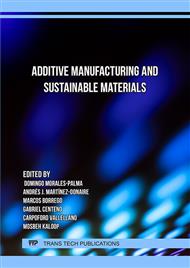p.131
p.139
p.149
p.157
p.165
p.177
p.187
p.195
p.201
On the Processability of Aluminium Alloys by PBF-L/M Additive Manufacturing Technology
Abstract:
The interest in aluminium alloys for Additive Manufacturing (AM) processes has increased significantly during the last years. Thanks to the freedom of design offered by AM technologies, specifically for Powder Bed Fusion – Laser/Metal (PBF-L/M), aluminium alloys have shown a high potential for their implementation in several industrial sectors. The combination of a reduced density together with high specific mechanical performance (e.g. Rp0.2 stress against density) and other materials properties, like a high thermal and electrical conductivity, or improved corrosion resistance, between others, make AM Al-alloys a great choice for the production of several applications, in particular for the aerospace industry. There are currently available several commercial Al-alloys in the market, although their maturity for producing final Al-products with the high quality required for the aerospace industry still need to be investigated. This paper explores the processability of different Al-alloys manufactured by PBF-L/M. This is analyzed by the development of a Design of Experiment (DoE) campaign for achieving the best processing parameters in order to produce full dense materials. There, bulk and surface density, void content and surface roughness are the main variables to be characterized at this initial step. Later, different thermal treatments are applied and evaluated for each alloy, aiming to produce the best mechanical characteristics, but also analysing other relevant aspects such the electrical resistivity and thermal conductivity.
Info:
Periodical:
Pages:
165-173
Citation:
Online since:
October 2023
Keywords:
Price:
Сopyright:
© 2023 Trans Tech Publications Ltd. All Rights Reserved
Share:
Citation:



